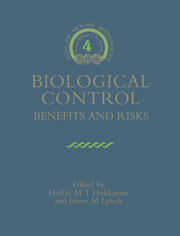Book contents
- Frontmatter
- Contents
- List of Contributors
- Series Preface
- Preface: Overview of Benefits and Risks of Biological Control Introductions
- Part I Biological Invasions
- Part II Classical Biocontrol
- Part III Augmentative Biocontrol
- 9 The Use of Exotic Organisms as Biopesticides: Some Issues
- 10 Use of Trichogramma in Maize – Estimating Environmental Risks
- 11 Entomopathogenic Nematodes in Biological Control: Feasibility, Perspectives and Possible Risks
- 12 Pseudomonads as Biocontrol Agents of Diseases Caused by Soil-borne Pathogens
- 13 Biological Control of Soil-borne Pathogens of Wheat: Benefits, Risks and Current Challenges
- 14 Genetically Engineered Fluorescent Pseudomonads for Improved Biocontrol of Plant Pathogens
- 15 Biological Control of Foliar Fungal Diseases
- 16 The Use of Fungi, Particularly Trichoderma spp. and Gliocladium spp., to Control Root Rot and Damping-off Diseases
- 17 Bacillus thuringiensis in Pest Control
- 18 Opportunities with Baculoviruses
- Part IV Use of Genetically Modified Organisms
- Part V Economics and Registration
- Index
11 - Entomopathogenic Nematodes in Biological Control: Feasibility, Perspectives and Possible Risks
Published online by Cambridge University Press: 07 May 2010
- Frontmatter
- Contents
- List of Contributors
- Series Preface
- Preface: Overview of Benefits and Risks of Biological Control Introductions
- Part I Biological Invasions
- Part II Classical Biocontrol
- Part III Augmentative Biocontrol
- 9 The Use of Exotic Organisms as Biopesticides: Some Issues
- 10 Use of Trichogramma in Maize – Estimating Environmental Risks
- 11 Entomopathogenic Nematodes in Biological Control: Feasibility, Perspectives and Possible Risks
- 12 Pseudomonads as Biocontrol Agents of Diseases Caused by Soil-borne Pathogens
- 13 Biological Control of Soil-borne Pathogens of Wheat: Benefits, Risks and Current Challenges
- 14 Genetically Engineered Fluorescent Pseudomonads for Improved Biocontrol of Plant Pathogens
- 15 Biological Control of Foliar Fungal Diseases
- 16 The Use of Fungi, Particularly Trichoderma spp. and Gliocladium spp., to Control Root Rot and Damping-off Diseases
- 17 Bacillus thuringiensis in Pest Control
- 18 Opportunities with Baculoviruses
- Part IV Use of Genetically Modified Organisms
- Part V Economics and Registration
- Index
Summary
Introduction
Although many mermithid, tylenchid, aphelenchid and rhabditid nematodes are known to be important antagonists of insects, very few nematode species have so far been used for biological control. The mermithid Romanomermis culicivorax was used in field trials to control malariatransmitting mosquitos (Petersen and Cupello, 1981). However, with the discovery of the larvicide Bacillus thuringiensis var. israelensis this nematode lost its significance. In Australia, the neotylenchid parasite Deladenus siricidicola is successfully released to control the introduced European sawfly Sirex noctilio (Bedding, 1984). Other species have never gone beyond the scientific research level, with the exception of rhabditid nematodes of the genus Steinemema and Heterorhabditis and their bacterial symbionts Xenorhabdus spp., which are widely used for biological control of insect larvae in cryptic environments.
Biology
The nematode's life cycle consists of a free-living and a propagative phase. The only stage occurring outside the host insect is the infective third stage dauer juvenile (Fig. 11.1), which is developmentally arrested and morphologically and physiologically adapted for long-term survival under detrimental environmental conditions in the soil. The dauer juveniles (DJs) do not take up nourishment and carry cells of their bacterial symbiont Xenorhabdus sp. in the intestinal lumen (Fig. 11.2) (Bird and Akhurst, 1983; Endo and Nickle, 1991). They actively seek out suitable host insects and penetrate the haemocoel where they find favourable conditions for propagation. The DJs start feeding, release the symbiotic bacteria into the haemolymph and enter into the propagative phase of the life cycle. Provided that the insect's humoral and cellular defence mechanisms do not succeed in the elimination of the nematodebacterium complex, the host will die within 2 days after infection.
- Type
- Chapter
- Information
- Biological ControlBenefits and Risks, pp. 119 - 136Publisher: Cambridge University PressPrint publication year: 1995
- 10
- Cited by



